Miele W865 User Manual

Operating instructions for Washing machine W 865
It is essential to read these operating instructions before installing or using the machine, to
avoid the risk of accidents, or damage to the machine.
G
M.-Nr. 05 603 360

Caring for our environment
Disposal of the packing material
The transport and protective packing has been selected from materials which are environmentally friendly for disposal and can normally be recycled.
Ensure that any plastic wrappings, bags etc. are disposed safely and kept out of the reach of babies and young children. Danger suffocation!
Rather than just throwing these materials away, please ensure they are offered for recycling.
Disposal of your old appliance
Old appliances contain materials which can be recycled. Please contact your dealer, your local waste collection centre or scrap merchant about potential recycling schemes.
Ensure that the appliance presents no danger to children while being stored for disposal. See the appropriate advice in the "Warning and safety instructions".
2

Contents
Caring for our environment. . . . . . . . . . . . . . . . . . . . . . . . . . . . . . . . . . . . . . . . . . 2 Disposal of the packing material . . . . . . . . . . . . . . . . . . . . . . . . . . . . . . . . . . . . . . . 2 Disposal of your old appliance . . . . . . . . . . . . . . . . . . . . . . . . . . . . . . . . . . . . . . . . 2
Guide to the machine. . . . . . . . . . . . . . . . . . . . . . . . . . . . . . . . . . . . . . . . . . . . . . . 6 Front view. . . . . . . . . . . . . . . . . . . . . . . . . . . . . . . . . . . . . . . . . . . . . . . . . . . . . . . . . 6 Control panel . . . . . . . . . . . . . . . . . . . . . . . . . . . . . . . . . . . . . . . . . . . . . . . . . . . . . . 7
Warning and safety instructions . . . . . . . . . . . . . . . . . . . . . . . . . . . . . . . . . . . . . 8
Washing environmentally and economically. . . . . . . . . . . . . . . . . . . . . . . . . . . 11
Before using for the first time. . . . . . . . . . . . . . . . . . . . . . . . . . . . . . . . . . . . . . . 12 Flushing out the machine. . . . . . . . . . . . . . . . . . . . . . . . . . . . . . . . . . . . . . . . . . . . 12 Water hardness reminder dial . . . . . . . . . . . . . . . . . . . . . . . . . . . . . . . . . . . . . . . . 12
How to wash correctly . . . . . . . . . . . . . . . . . . . . . . . . . . . . . . . . . . . . . . . . . . . . . 13 Brief guide . . . . . . . . . . . . . . . . . . . . . . . . . . . . . . . . . . . . . . . . . . . . . . . . . . . . . . . 13 Before washing . . . . . . . . . . . . . . . . . . . . . . . . . . . . . . . . . . . . . . . . . . . . . . . . . 13 To start a programme . . . . . . . . . . . . . . . . . . . . . . . . . . . . . . . . . . . . . . . . . . . . 14 At the end of a programme. . . . . . . . . . . . . . . . . . . . . . . . . . . . . . . . . . . . . . . . 16 Adding or removing washing after programme start. . . . . . . . . . . . . . . . . . . . . . . 17 Programme . . . . . . . . . . . . . . . . . . . . . . . . . . . . . . . . . . . . . . . . . . . . . . . . . . . . . . 18
. . . interruption . . . . . . . . . . . . . . . . . . . . . . . . . . . . . . . . . . . . . . . . . . . . . . . . . 18
. . . alteration . . . . . . . . . . . . . . . . . . . . . . . . . . . . . . . . . . . . . . . . . . . . . . . . . . . 18
. . . Skipping a programme stage . . . . . . . . . . . . . . . . . . . . . . . . . . . . . . . . . . . 18
Adding detergent . . . . . . . . . . . . . . . . . . . . . . . . . . . . . . . . . . . . . . . . . . . . . . . . . 19 It is important to dispense the correct amount, because . . . . . . . . . . . . . . . . . . . 19 Adding detergent. . . . . . . . . . . . . . . . . . . . . . . . . . . . . . . . . . . . . . . . . . . . . . . . . . 20 Water softeners . . . . . . . . . . . . . . . . . . . . . . . . . . . . . . . . . . . . . . . . . . . . . . . . . . . 20 Fabric conditioners, texturisers, liquid starch . . . . . . . . . . . . . . . . . . . . . . . . . . . . 20
Automatic fabric conditioners, texturisers, or liquid starch . . . . . . . . . . . . . . . 21 Separate fabric conditioner or texturiser . . . . . . . . . . . . . . . . . . . . . . . . . . . . . 21 Starching separately. . . . . . . . . . . . . . . . . . . . . . . . . . . . . . . . . . . . . . . . . . . . . 21
3

Contents
Programmes . . . . . . . . . . . . . . . . . . . . . . . . . . . . . . . . . . . . . . . . . . . . . . . . . . . . . 22 Programme selection . . . . . . . . . . . . . . . . . . . . . . . . . . . . . . . . . . . . . . . . . . . . . . . 22 Sequence. . . . . . . . . . . . . . . . . . . . . . . . . . . . . . . . . . . . . . . . . . . . . . . . . . . . . . . . 24 Care symbols - washing . . . . . . . . . . . . . . . . . . . . . . . . . . . . . . . . . . . . . . . . . . 26
Additional options . . . . . . . . . . . . . . . . . . . . . . . . . . . . . . . . . . . . . . . . . . . . . . . . 28 Soak . . . . . . . . . . . . . . . . . . . . . . . . . . . . . . . . . . . . . . . . . . . . . . . . . . . . . . . . . . . . 28 Pre-wash . . . . . . . . . . . . . . . . . . . . . . . . . . . . . . . . . . . . . . . . . . . . . . . . . . . . . . . . 28 Short. . . . . . . . . . . . . . . . . . . . . . . . . . . . . . . . . . . . . . . . . . . . . . . . . . . . . . . . . . . . 28 Water plus . . . . . . . . . . . . . . . . . . . . . . . . . . . . . . . . . . . . . . . . . . . . . . . . . . . . . . . 29 Spin . . . . . . . . . . . . . . . . . . . . . . . . . . . . . . . . . . . . . . . . . . . . . . . . . . . . . . . . . . . . 29






 . . . . . . . . . . . . . . . . . . . . . . . . . . . . . . . . . . . . . . . . . . . . . . . . 29
. . . . . . . . . . . . . . . . . . . . . . . . . . . . . . . . . . . . . . . . . . . . . . . . 29




 . . . . . . . . . . . . . . . . . . . . . . . . . . . . . . . . . . . . . . . . . . . . . . . . . . . . . 29 Electronic programme locking. . . . . . . . . . . . . . . . . . . . . . . . . . . . . . . . . . . . . . . . 30
. . . . . . . . . . . . . . . . . . . . . . . . . . . . . . . . . . . . . . . . . . . . . . . . . . . . . 29 Electronic programme locking. . . . . . . . . . . . . . . . . . . . . . . . . . . . . . . . . . . . . . . . 30
Programmable functions. . . . . . . . . . . . . . . . . . . . . . . . . . . . . . . . . . . . . . . . . . . 31 Maximum water level . . . . . . . . . . . . . . . . . . . . . . . . . . . . . . . . . . . . . . . . . . . . . . . 31 Water plus system . . . . . . . . . . . . . . . . . . . . . . . . . . . . . . . . . . . . . . . . . . . . . . . . . 32 Activating the i compartment. . . . . . . . . . . . . . . . . . . . . . . . . . . . . . . . . . . . . . . 34 Soak time . . . . . . . . . . . . . . . . . . . . . . . . . . . . . . . . . . . . . . . . . . . . . . . . . . . . . . . . 35 Gentle action . . . . . . . . . . . . . . . . . . . . . . . . . . . . . . . . . . . . . . . . . . . . . . . . . . . . . 36 Top-up rinse for Cottons . . . . . . . . . . . . . . . . . . . . . . . . . . . . . . . . . . . . . . . . . . . . 37 Memory function . . . . . . . . . . . . . . . . . . . . . . . . . . . . . . . . . . . . . . . . . . . . . . . . . . 38
Cleaning and care . . . . . . . . . . . . . . . . . . . . . . . . . . . . . . . . . . . . . . . . . . . . . . . . 39 Cleaning the washing machine . . . . . . . . . . . . . . . . . . . . . . . . . . . . . . . . . . . . . . . 39 Extra cleaning . . . . . . . . . . . . . . . . . . . . . . . . . . . . . . . . . . . . . . . . . . . . . . . . . . . . 39 Cleaning the detergent dispenser drawer. . . . . . . . . . . . . . . . . . . . . . . . . . . . . . . 40 Cleaning the fluff (drain) filter and pump . . . . . . . . . . . . . . . . . . . . . . . . . . . . . . . . 41 To clean the water inlet filters. . . . . . . . . . . . . . . . . . . . . . . . . . . . . . . . . . . . . . . . . 43
To clean the filter in the union in the open end of the inlet hose: . . . . . . . . . . . 43 To clean the filter in the water inlet valve: . . . . . . . . . . . . . . . . . . . . . . . . . . . . . 43
4

Contents
Problem solving guide. . . . . . . . . . . . . . . . . . . . . . . . . . . . . . . . . . . . . . . . . . . . . 44 The programme does not start. . . . . . . . . . . . . . . . . . . . . . . . . . . . . . . . . . . . . . . . 44 The wash programme stops and a fault indicator light comes on. . . . . . . . . . . . . 45 A fault indicator light comes on but the wash programme continues as normal. . 46 General problems or an unsatisfactory wash result . . . . . . . . . . . . . . . . . . . . . . . 47 Opening the drum door in the event of a power failure . . . . . . . . . . . . . . . . . . . . . 50
After sales service . . . . . . . . . . . . . . . . . . . . . . . . . . . . . . . . . . . . . . . . . . . . . . . . 51 Customer contact . . . . . . . . . . . . . . . . . . . . . . . . . . . . . . . . . . . . . . . . . . . . . . . . . 51 Appliance guarantee . . . . . . . . . . . . . . . . . . . . . . . . . . . . . . . . . . . . . . . . . . . . 51 Future updates (PC). . . . . . . . . . . . . . . . . . . . . . . . . . . . . . . . . . . . . . . . . . . . . . . . 51
Installation . . . . . . . . . . . . . . . . . . . . . . . . . . . . . . . . . . . . . . . . . . . . . . . . . . . . . . 52 Installation surface. . . . . . . . . . . . . . . . . . . . . . . . . . . . . . . . . . . . . . . . . . . . . . . . . 52 Installation . . . . . . . . . . . . . . . . . . . . . . . . . . . . . . . . . . . . . . . . . . . . . . . . . . . . . . . 52 Removing the transit fitting . . . . . . . . . . . . . . . . . . . . . . . . . . . . . . . . . . . . . . . . . . 52 Re-fitting the transit bars . . . . . . . . . . . . . . . . . . . . . . . . . . . . . . . . . . . . . . . . . . . . 53 Levelling the machine . . . . . . . . . . . . . . . . . . . . . . . . . . . . . . . . . . . . . . . . . . . . . . 54
Screwing out and adjusting the feet . . . . . . . . . . . . . . . . . . . . . . . . . . . . . . . . . 54 Building under a worktop. . . . . . . . . . . . . . . . . . . . . . . . . . . . . . . . . . . . . . . . . . . . 55 Washer and Dryer stack . . . . . . . . . . . . . . . . . . . . . . . . . . . . . . . . . . . . . . . . . . 55 Connection to water supply . . . . . . . . . . . . . . . . . . . . . . . . . . . . . . . . . . . . . . . . . . 56 Connection to the drainage system. . . . . . . . . . . . . . . . . . . . . . . . . . . . . . . . . . . . 57 Electrical connection U.K. . . . . . . . . . . . . . . . . . . . . . . . . . . . . . . . . . . . . . . . . . . . 58
Consumption data . . . . . . . . . . . . . . . . . . . . . . . . . . . . . . . . . . . . . . . . . . . . . . . . 60
Technical Data . . . . . . . . . . . . . . . . . . . . . . . . . . . . . . . . . . . . . . . . . . . . . . . . . . . 61
5
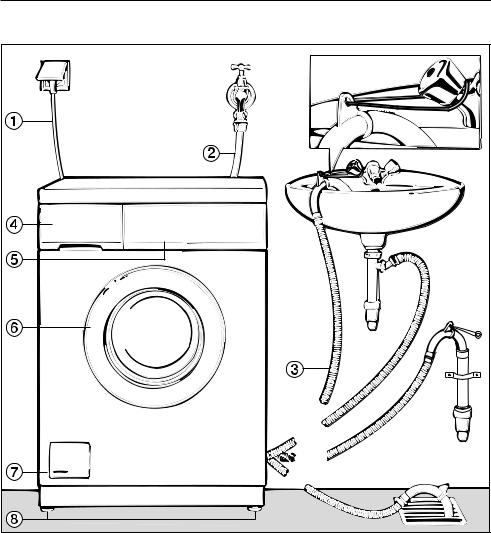
Guide to the machine
Front view
aElectric supply cable
bInlet hose (able to withstand pressures of at least 70 bar)
cFlexible drain hose (with detachable swivel elbow)
dDetergent dispenser drawer
eFacia panel with controls
fDoor
gAccess panel for drain pump, drain filter and emergency door release
hFour height adjustable feet
6
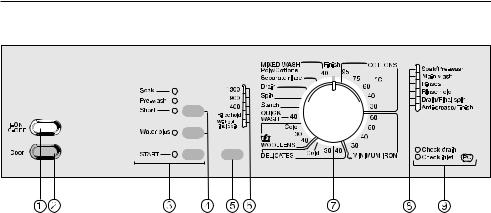
Guide to the machine
Control panel
aI-ON/0-OFF button
To switch the machine ON or OFF or to interrupt a programme.
bDoor button
Opens the machine door.
cSTART button
Starts the wash programme
dButtons for additional functions
The upper button is used to select either the Soak, pre-wash or Short wash additional option.
The lower button is used to select the additional option Water plus.
Indicator light on = selected Indicator light off = not selected
e"Spin" button
For spin speed, Rinse hold and Without final spin
fIndicator lights
Showing the selected spin speed.
gProgramme selector
Can be turned clockwise and anti-clockwise.
hProgramme sequence indicator lights
iCheck lights
7

Warning and safety instructions
Read the operating instructions before using this machine for the first time. They contain important information about the safety, use and maintenance of the machine. This way you will avoid the risk of accidents and damage to the machine. Keep these operating instructions in a safe place and ensure that new users are familiar with the content. Pass them on to any future owner of the machine.
Correct usage
Only use the washing machine to wash items which are specified by
the manufacturer to be machine-wash- able on the wash-care label, and textiles composed of hand-washable wool or wool blend fabrics as well as satin, lace, silk and other hand-washable garments.
Any other applications may be dangerous. The manufacturer is not liable for damage resulting from improper use or operation.
This appliance should not be operated by children. Supervise its use
by the elderly or infirm.
Technical safety
Before setting up the machine, check it for any externally visible
damage. Do not install and use a damaged machine.
Before connecting the machine, ensure that the connection data on
the data plate (fusing, voltage and frequency) match the mains electricity
supply. If in any doubt, consult a qualified electrician.
The electrical safety of this appliance can only be guaranteed when
continuity is complete between the machine and an effective earthing system which complies with local and national regulations. It is most important that this basic safety requirement is regularly tested by a qualified electrician.
The manufacturer cannot be held liable for the consequences of an inadequate earthing system (e.g. electric shock).
Do not connect the appliance to the mains electricity supply by an
extension lead. Extension leads do not guarantee the required safety of the appliance (e.g. danger of overheating).
The machine is built in accordance with current safety requirements.
Unauthorised repairs could result in unforeseen dangers for the user, for which the manufacturer cannot accept liabilty. Repairs should only be undertaken by a Miele approved engineer.
Ensure current is not supplied to the appliance while maintenance or repair work is being carried out.
The machine is only completely isolated from the electricity supply
when:
–it is switched off at the wall socket and the plug is withdrawn, or
–it is switched off at the mains, or
–the mains fuse is withdrawn.
8

Warning and safety instructions
This machine must only be connected to the on-site water supply
using a new hose kit. Old hoses must not be re-used. Check the hose regularly for signs of wear and tear. Change in good time to avoid the risk of leaks and subsequent damage.
Faulty components must only be exchanged for Miele original spare
parts. Only when these parts are fitted can the safety standards of the machine be guaranteed.
In countries where there are areas which may be subject to infestation
by cockroaches or other vermin, pay particular attention to keeping the appliance and its surroundings in a clean condition at all times. Any damage which may be caused by cockroaches or other vermin will not be covered by the appliance guarantee.
Use
This equipment is not designed for maritime use or for use in mobile
installations such as caravans, aircraft etc. However it may be suitable for such usage subject to a risk assessment of the installation being carried out by a suitably qualified engineer.
Do not install your washing machine in rooms where temperatures
below freezing may occur. Frozen hoses may burst under pressure. The reliability of the electronic control system may be impaired at temperatures below freezing point.
Before using the machine for the first time, check that the transit fit-
ting at the rear of the machine has been removed (see section on "Installation"). During spinning, a transit fitting which is still in place may result in damage to both the machine and adjacent furniture or appliances.
Turn off the stopcock if the machine is to be left for any length of
time (e.g. holiday), especially if there is no floor drain (gully) in the immediate vicinity.
Flooding danger.
If hooking the drain hose into a wash basin, check that the water can drain off quickly enough to prevent the sink from overflowing.
Make sure the drain hose is secure, so that the force of the water flowing out of the hose does not dislodge it. Otherwise this will result in flooding.
Take care to ensure that foreign objects (e.g. nails, needles, coins,
paper clips, etc.) do not find their way into the machine with the washing (e.g. in pockets). Foreign objects can damage components of the machine, which in turn can result in damage to the washing.
9

Warning and safety instructions
If the correct amount of detergent is dispensed, the machine should not need to be descaled. If, however,
you do wish to descale the machine only use proprietary non-corrosive descaling agents and strictly observe the instructions on the packaging. If in doubt, contact the Miele Customer Service Dept. or your Miele Dealer.
Textiles which have been pre-treated in solvent based clean-
ing agents must be thoroughly rinsed in clean water before being washed in the machine.
Never use solvent based cleaning agents in this machine, as this may
result in damage to component parts and create toxic fumes. Such detergents also pose a fire and explosion hazard.
Only use dyes specified by the manufacturer as being suitable for
use in a domestic washing machine. Always observe the manufacturer's instructions carefully.
Colour run and dye removers contain sulphur compounds which can
cause damage such as corrosion. Do not use these products in this machine.
For machines with a ‘porthole’ door, remember that the porthole
glass will be hot when washing at very high temperatures. Do not let children touch it.
Always make sure the drum is stationary before reaching in to re-
move washing. Reaching into a moving drum is extremely dangerous.
Accessories
Accessory parts may only be fitted when expressly approved by Miele.
If other parts are used, guarantee, performance and product liability claims will be invalidated.
Disposal of your old machine
Before discarding an old machine unplug it. Render the plug useless.
Cut off the cable directly behind the appliance to prevent misuse. This should be done by a competent person.
10

Washing environmentally and economically
–Water consumption and energy usage are determined by the size of the load. Load to the maximum recommended for the programme selected.
–Programme durations can vary considerably due to the automatic load adjustment feature. Depending on the amount of laundry, the main wash may be shortened and one rinse omitted.
–Use the Mixed Wash programme or the Quick Wash programme for smaller amounts of laundry.
–To save energy wash normally and lightly soiled laundry at lower temperatures. The 95°C Cottons programme is probably only needed in exceptional circumstances, e.g. for oil based stains or where a very hot wash is required.
–A main wash (programme without pre-wash) is sufficient to clean normally soiled laundry.
–By using the additional option Soak for heavily soiled laundry you can select a lower temperature in the main wash.
–Use the additional option Soak instead of Pre-wash with heavily soiled laundry.
If Soak is followed immediately by a main wash the same suds are used.
–Use the Short wash option for normally or very lightly soiled laundry.
–Do not exceed the amounts of detergent which may be recommended by the manufacturer on the packaging.
–Reduce the amounts of detergent with smaller loads, (e.g. with a half load, approx. one third less detergent).
–Select the highest suitable spin speed in the wash programme when tumble drying afterwards.
11
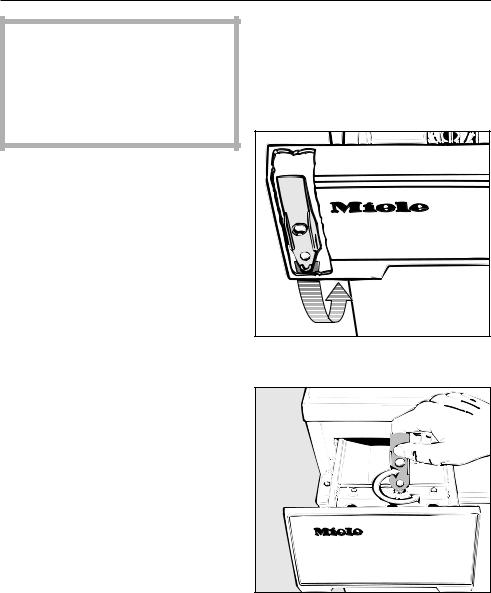
Before using for the first time
Before using the machine for the first time ensure that it is correctly installed and connected. See the relevant section under "Installation". Also check that the fluff filter is securely tightened. Otherwise there is a risk of water leakage during use.
Water hardness reminder dial
Several factors including the water hardness level in your area will affect how much detergent you should use. The small dial in the detergent dispenser drawer can be set purely as a reminder of the hardness level.
Flushing out the machine
Any residual lubricants and water from testing still in the machine should be flushed out as follows:
^Turn on the stopcock.
^Do not load any laundry.
^Add detergent to compartment j, however only add max.1/4 of the amount recommended on the packaging for a full load.
^Press the I-ON/0-OFF button in.
^Turn the programme selector to COTTONS 60°C.
Important!
This programme must be selected in order to prepare the machine for spinning and to activate the ball valve.
^Press the Water plus button in. The indicator light next to it will come on.
^Press the "Spin" button repeatedly until the Without final spin indicator light comes on.
^Press the START button.
^When this programme has finished your washing machine is ready for using for the first time.
^Remove the yellow spatula from inside the dispenser drawer.
^Adjust the dial to the appropriate setting (1 = soft, 4 = very hard).
12
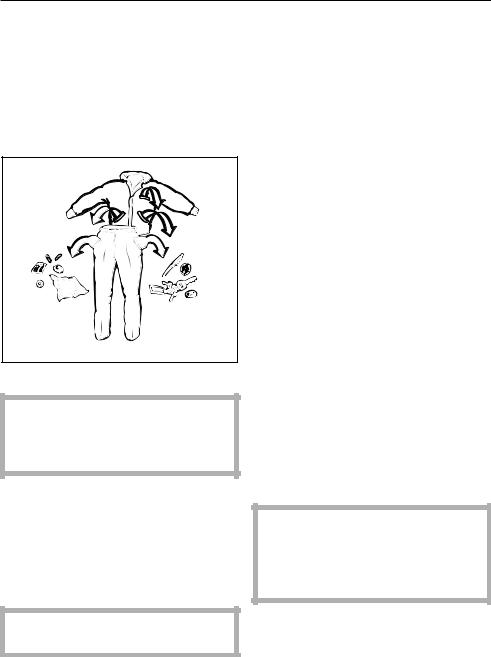
How to wash correctly
Brief guide
The headings numbered (A,B,C,...) show the operating sequence and can be used as a brief guide.
Before washing
ASort the laundry.
^ Empty all pockets.
Foreign objects (e.g. nails, coins, paper clips, etc.) can cause damage to textiles and components in the machine.
^Badly soiled areas, e.g. collars and cuffs, and water soluble stains can be pre-treated with bar soap, liquid detergent or detergent mixed into a solution or paste.
With particularly stubborn stains ask your dry cleaner for advice.
Do not use solvent-based cleaning agents in this machine.
^Sort the washing by colour and by care label symbols. Most garments have a textile care label in the collar or side seam.
Dark textiles often contain excess dye and should be washed separately several times before being included in a mixed load. Always wash whites and coloureds separately.
Delicate textiles should be washed separately in a delicates programme (use a washing bag where appropriate).
–Curtains:
Remove lead weights and strips or place in a laundry bag.
–Underwiring and collar stiffeners: Any loose wiring in bras, shirt collar stiffeners, etc. should be removed or sewn in.
–Knitted garments, trousers and jeans, T-shirts and sweat shirts: Turn inside out, if recommended by the manufacturer.
–Close any zips, fasten hooks and eyes etc. before washing.
–Fasten duvet covers to prevent smaller items rolling up inside them.
Do not wash any items in this machine which are specified by the manufacturer as non-machine washable on the care label. (h symbol)
13
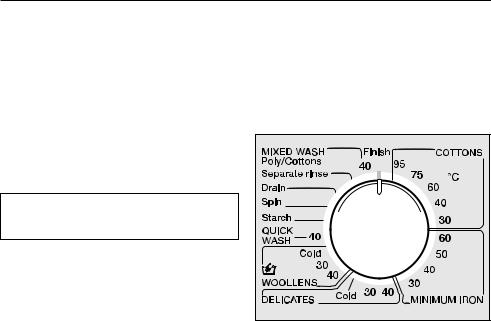
How to wash correctly
BPress the Door button.
CLoad the drum.
Unfold washing and load loosely in the drum. To achieve best results it is advisable to make up mixed loads consisting of both large and small items. This improves the washing effect and helps distribute the load evenly to keep the machine stable and reduce the noise level during spinning.
Overloading reduces the wash result and causes more creasing.
Maximum load weights are noted below:
COTTONS . . . . . . . . . . . . . . . . . . 5.0 kg MINIMUM IRON. . . . . . . . . . . . . . 2.5 kg DELICATES/SYNTHETICS . . . . . . 1.0 kg WOOLLENS /. . . . . . . . . . . . . . 2.0 kg QUICK WASH . . . . . . . . . . . . . . . 2.5 kg MIXED WASH (Poly/Cottons). . . . 3.0 kg
DShut the door with a light swing but do not slam it. Do not push on the door to shut it.
Make sure that there is no obstruction between the drum door and seal.
EOpen the stopcock.
FAdd detergent.
See section on "detergent" for details.
To start a programme
GPress in the I-ON/0-OFF button.
–The programme selector should be pointing to Finish, the indicator light
Anti crease/Finish is lit up in the sequence display.
HTurn the programme selector to the programme required
See section "Programmes, Programme survey".
14
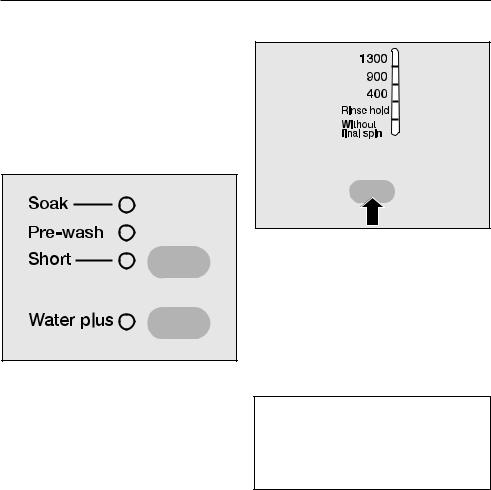
How to wash correctly
ISelect any additional option required.
A maximum of two additional options can be chosen, provided they are compatible with the programme selected, (see the Programme survey in the Section on programmes). Only one option out of Soak, Pre-wash and Short wash can be selected.
^Press the button for the Soak,
Pre-wash or Short wash additional options, until the indicator for the chosen option lights up.
^Press the button for the Water plus option, if required.
An additional option that has been selected can be de-selected by pressing the button.
JSelect a spin speed.
^Press the "Spin" button enough times until the indicator light for the required final spin speed lights up.
In some programmes the maximum spin speed is limited. The machine will not allow a higher spin speed to be selected (see section on "programmes").
Memory-Function
If the last time a programme was run an additional option or different spin speed was selected,the machine will have stored this information in its memory.
The next time that programme is selected the machine offers the additional option and / or spin already stored in memory (see "Programmable functions").
KPress the START button.
The programme now starts.
15
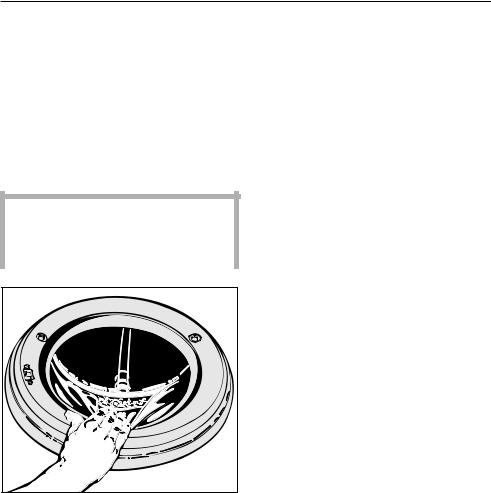
How to wash correctly
At the end of a programme
When the Finish indicator light comes on the laundry can be removed from the drum:
LPress the Door button.
MPress and release the I-ON/0-OFF button and turn the programme selector to the Finish position.
NRemove the washing.
,Only remove washing from the machine once the drum has stopped turning, otherwise you may seriously injure yourself.
OCheck the folds in the door seal for any small articles e.g. buttons which might be lodged there.
PClose the stopcock.
QClose the drum door.
Otherwise there is a danger of objects being placed inadvertently in the drum. If these remained unnoticed and were washed in the next load, they could damage the washing.
16

How to wash correctly
Adding or removing washing after programme start
Washing can be added or removed after the programme has already started, when using the following programmes.
–COTTONS
–MINIMUM IRON
–WOOLLENS /
–QUICK WASH
–Starch
–MIXED WASH
^Press the Door button and hold it until the door springs open.
^Add or remove items
^Shut the door.
The programme will automatically continue.
–Apart from some exceptional cases the door can be opened during all sections of COTTONS, WOOLLENS, QUICK WASH, Starch and MIXED WASH - Poly/Cottons (high cotton percentage) programmes.
–With MINIMUM IRON and
MIXED WASH - Poly/Cottons (high polyester percentage) the door can be opened during the main wash with some exceptions.
General exceptions:
The door cannot be opened when:
–the suds temperature is above 55°C.
–the additional option Water plus has been selected,
–programme locking is switched on,
–the programme has reached the Final spin stage.
17

How to wash correctly
Programme . . .
.. . interruption
^Press the I-ON/0-OFF button.
^To continue with the same programme press the I-ON/0-OFF button again.
. . . alteration
The machine will accept the following changes after the START button has been pressed,
–selection of a different temperature, extra selection or de-selection of the Water plus option can be carried out up to 6 minutes after start.
–the spin speed for final spin can be changed if the programme permits.
After start it is no longer possible to select a different programme.
If a different programme or 6 minutes after start another temperature is selected the indicator light
Anti-crease/Finish flashes. This does not affect the programme sequence. The indicator light goes out when the programme selector is set back to the programme or temperature previously chosen.
To select a different programme proceed as follows:
^With the I-ON/0-OFF button switch off the appliance.
^Turn the programme selector to Finish.
^Switch the machine on with the I-ON/0-OFF button.
^Select a new programme.
^Press the START button.
. . . Skipping a programme stage
^Turn the programme selector to Finish.
As soon as the programme sequence light for the stage at which the programme should continue starts flashing:
^Turn the programme selector switch to the appropriate programme within 4 seconds.
When programme locking has been activated the programme cannot be changed nor can a programme stage be repeated or left out.
18

Adding detergent
All modern detergents produced for automatic washing machines are suitable, including liquid, compact (concentrated), tablets, liquid tablets and special application detergents. Use dispensing aids, e.g. balls, if these are supplied with the detergent. Tablets are suitable for full loads, but note that it may be impractical to reduce tablets by proportion to suit smaller loads.
Woollens and knitwear containing wool mixtures and hand-washable garments should be washed using a detergent specifically designed for washing woollens.
Silk should be washed using a liquid detergent specifically designed for washing woollens. Do not use biological detergents on silk as the enzymes may damage the silk!
Add detergent according to the amount recommended on the packaging. The right amount to dispense will depend on the following:
–The quantity of laundry.
–The soiling level of the laundry.
Lightly soiled
No visible dirt or stains. Possibly slight body odour.
Normally soiled
Visibly dirty and/or just a few slight stains.
Heavily soiled
Stains and soiling clearly visible.
–The water hardness level
Check with your local water supplier if you do not know the water hardness level in your area.
Water Hardness
Hardness |
Type of |
Hardness |
°dH |
||
range |
water |
level in |
German |
||
|
(hardness) |
mmol / l |
|
|
|
I |
soft |
0 |
- 1.3 |
|
0 - 7 |
II |
medium |
1.3 |
- 2.5 |
7 |
- 14 |
III |
hard |
2.5 |
- 3.8 |
14 |
- 21 |
IV |
very hard |
over 3.8 |
over 21 |
||
It is important to dispense the correct amount, because . . .
. . . too little has the following results:
–Laundry will not be properly clean and will in time become grey and hard to the touch.
–Greasy particles cling to the laundry.
–Limescale deposits on the heater elements.
. . . too much results in the following:
–Excessive foam.
–Low level of agitation.
–Poor washing, rinsing and spinning results.
–High water consumption (an additional rinse cycle will automatically switch in).
–Burdening the environment.
19
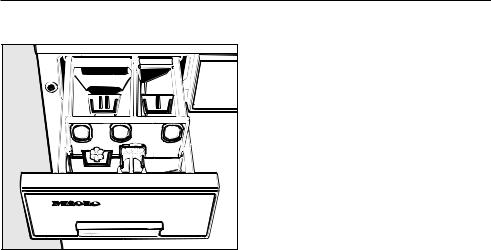
Adding detergent
Adding detergent |
Water softeners |
i= Compartment for pre-wash. This compartment is also used for starch formulations when starching separately.
j = Compartment main wash
p = Compartment fabric conditioner
Water is taken in through compartment i in the pre-wash.
Water is taken in through compartment j in the main wash. If the capacity of compartment j is insufficient for the amount of detergent needed for a COTTONS programme (e.g. in very hard water areas), the machine can be programmed so that water and detergent can also be taken into the main wash through compartment i , see "Programmable functions", "Activating compartment i".
A water softener can be used to cut down on the use of detergents in extremely hard water areas. Dispense according to the amount specified on the packaging. First add detergent and then the water softener.
Dispense detergent as specified for soft water areas.
Miele do not recommend connecting the machine to a household water softener.
If you wash using several components (e.g. special application detergents), we recommend always dispensing the agents into compartment j in the following order:
1.Detergent
2.Water softener
3.Stain remover
This way the agents are distributed more efficiently.
Fabric conditioners, texturisers, liquid starch
Fabric conditioners make garments soft and fluffy to handle and help prevent static cling when tumble drying.
Texturisers are synthetic starch formulations and give body to items e.g. shirts, tablecloths and bed linen.
Starch gives body to items of washing.
^Dispense according to the amount specified on the packaging.
20
